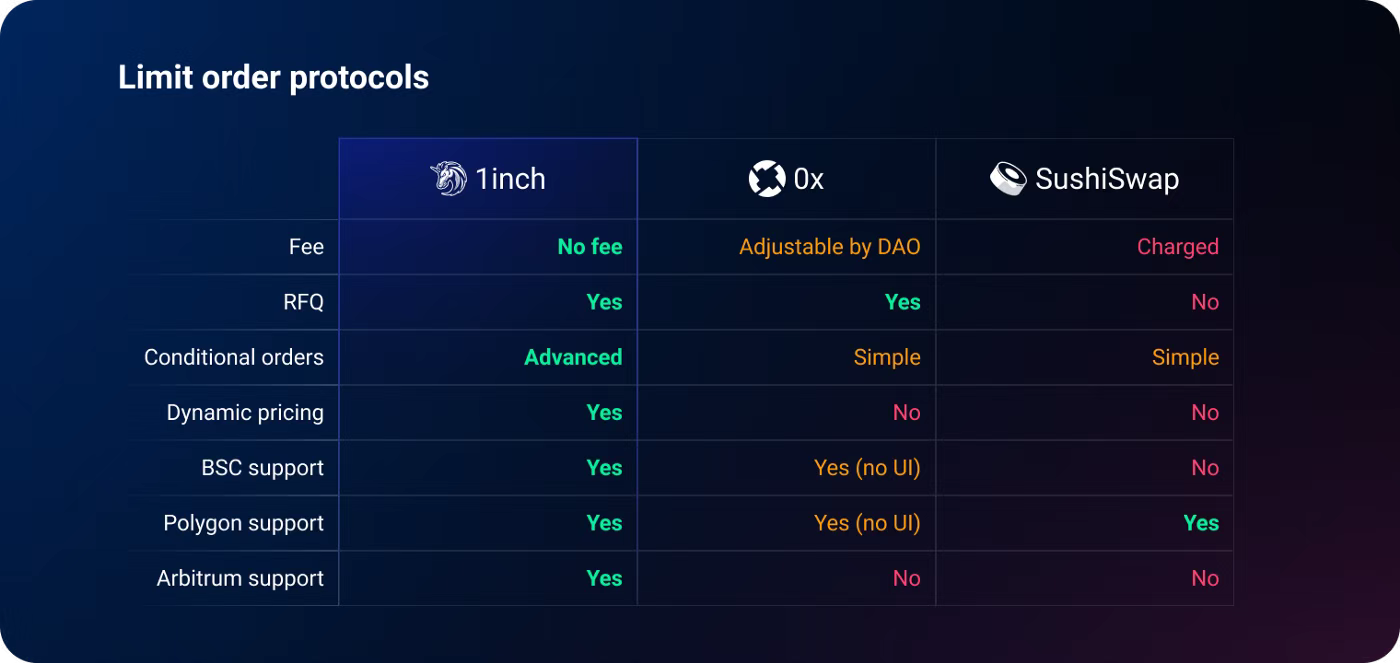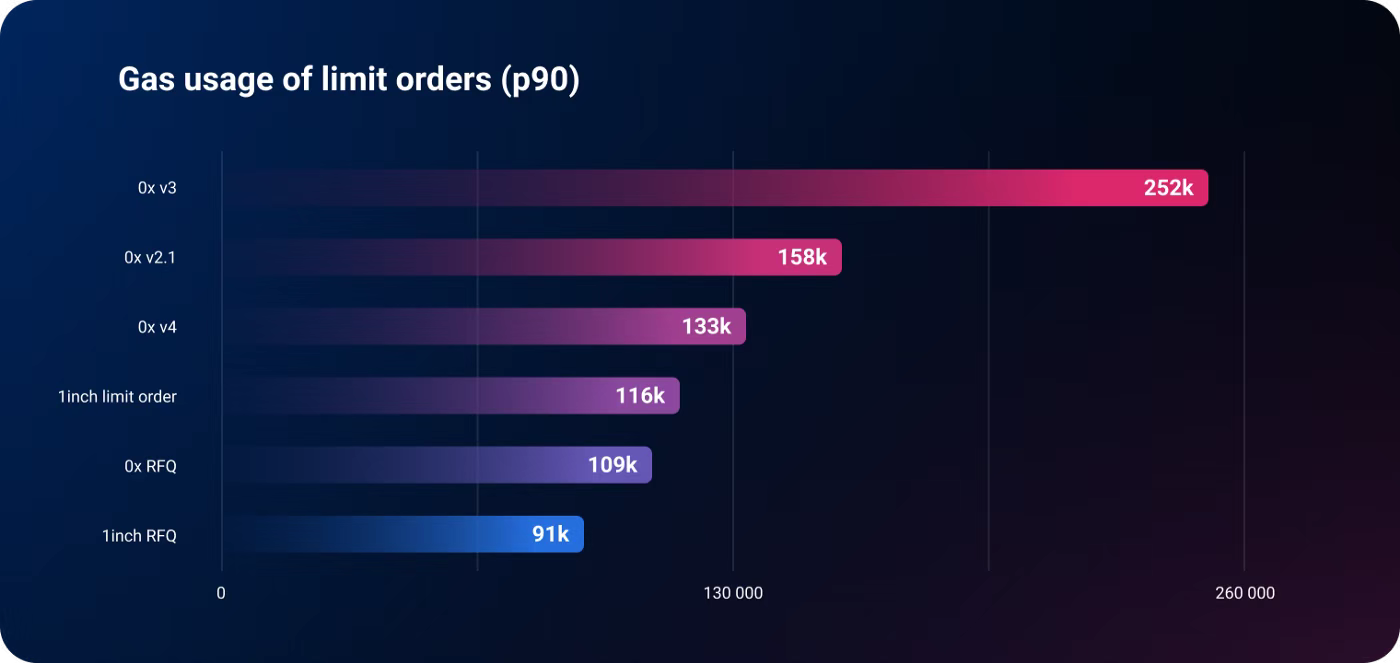, the original author: 1inch, compiled by Odaily translator Katie Gu.
As decentralized exchanges (DEX) develop, their functionality becomes more and more advanced, gradually becoming comparable to centralized exchanges (CEX). One of these features is limit orders. In this article, we will discuss the current state of limit order agreements and analyze their pros and cons.
Unlike market orders, which are executed immediately at the last market price, limit orders are executed as soon as a predetermined price is reached. Most DEXs based on automated market makers (AMM) choose the market order system by default. Simple and easy to understand for newcomers. Market orders are either executed or fail due to parameters such as maximum price impact.https://www.paradigm.xyz/2021/07/twamm/)。
Another idea proposed by Paradigm is to use a time-weighted AMM that progressively trades over a period of time (see:
It can also be said that limit orders are for more advanced traders, as they require analyzing market conditions and assessing the likelihood of an asset's price reaching a certain level. At the same time, limit orders are a great tool for professional market makers (PMMs), which can significantly increase the profitability of trading. Filling limit orders on the blockchain also takes into account gas costs (based on order size).
Just like CEX, there are also decentralized protocols that provide limit order functionality, such as SushiSwap and 0x.

This summer, 1inch released a limit order protocol, including several advanced features. This chart compares the difference between the limit order functions provided by three mainstream DEXs:In terms of transaction costs, the 1inch limit order protocol has an advantage over its competitors as there are no additional fees.
In addition, the 1inch limit order protocol provides advanced features never seen in DeFi, including dynamic pricing and conditional execution, as well as a request for quotation function (RFQ).
secondary title
Request for Quotation (RFQ)
The Request for Quote Function (RFQ) can be viewed as an over-the-counter trading system for decentralized exchanges, enabling market makers to transfer liquidity from CEXs to DEX users. This provides better pricing for medium to large transactions.
CEX and cross-chain liquidity have been connected to 1inch, which is more convenient than any so-called "cross-chain exchange".
The purpose of the RFQ system is to make it easy and profitable to provide large amounts of liquidity to DEXs, while also reducing risk. Because the RFQ system enables market makers to choose when and with whom to trade, they can maximize the ratio of retail order flow to arbitrage flow.
The RFQ feature enables professional market makers who typically trade crypto assets on CEXs or OTC options to trade large volumes of cryptocurrencies on DEXs with low risk. With the inquiry function, professional market makers have transferred a large amount of liquidity from CEX to DEX.
Additionally, the RFQ system provides better gas utility. While filling a simple market order will cost 90k gas fees, in the 1inch limit order protocol, an inquiry order will cost 70k gas fees.
secondary title
Thanks to conditional execution, users can maximize their trading profits by specifying the conditions under which orders are executed. The conditional execution feature of the 1inch limit order protocol facilitates specifying fully dynamic conditions, for example, can rely on oracles. Specifically, the stop loss order is based on the price from the oracle.
secondary title
dynamic pricing
A promising application of dynamic pricing is auctions. A limit order can be placed in such a way that the price will increase or decrease. Similarly, the dynamic pricing feature can support other token sales based on auction models or NFT auctions.
secondary title
Stop Orders and Trailing Stop Orders
Conditional execution and dynamic pricing capabilities can facilitate a range of functions. For example, stop orders and trailing stop orders.
Stop orders are only issued when certain price conditions are met, and the price data is provided by the oracle. For example, “Sell wETH for $2000 when the price of the oracle drops below $2000.” Stop orders can be used in conjunction with market or limit orders, which gives traders greater flexibility and the creation of more complex strategies Opportunity.
Basically, the difference between limit orders and stop orders is that limit orders are on the order book where anyone can see them, whereas stop orders are only submitted when the initially determined price is reached.
Unlike a stop order, which requires "buy/sell immediately if price reaches X", a stop limit order requires "buy/sell order at Y if price reaches X", X and Y can be have the same value, but not necessarily.
For example, the combination of stop order and stop limit order is: "If the oracle price of bitcoin is below $30,500, then sell bitcoin at $30,000."
A stop loss is a market order that sets a stop price at a specific percentage below the market price of an asset, rather than a single value. After that, when the asset price changes, the stop loss order will follow in real time, so it is called "trailing stop loss". An example of a trailing stop order is: "Sell this product if the price of this product falls $300 from today's high price."
These functions provided by the 1inch limit order protocol can be developed by third parties at a later stage, because the protocol is open source and can be combined/extended.
secondary title
Gas utility
Across the four versions of the 0х protocol, we calculated gas usage for ask order executions, as well as gas usage for regular limit and ask orders in the 1inch limit order protocol.

It turns out that 1inch RFQ orders consume the least gas, making them the most profitable orders for traders in terms of total price.
secondary title
Multi-chain support and integration
Another advantage of the 1inch limit order protocol is its multi-chain support. Deployed on the Ethereum, Binance Smart Chain, Polygon, and Arbitrum networks, the protocol extends limit order functionality beyond the Ethereum ecosystem.
secondary title
Summarize
Summarize



